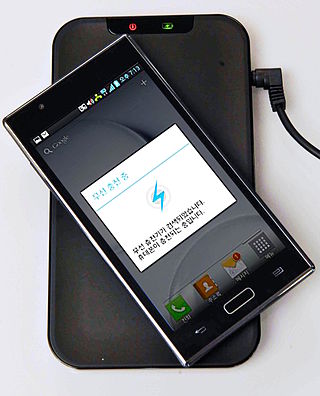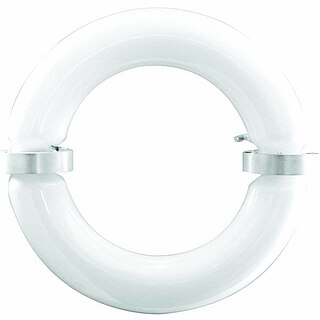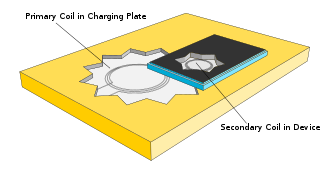
An electromagnetic coil is an electrical conductor such as a wire in the shape of a coil. Electromagnetic coils are used in electrical engineering, in applications where electric currents interact with magnetic fields, in devices such as electric motors, generators, inductors, electromagnets, transformers, and sensor coils. Either an electric current is passed through the wire of the coil to generate a magnetic field, or conversely, an external time-varying magnetic field through the interior of the coil generates an EMF (voltage) in the conductor.

An inductor, also called a coil, choke, or reactor, is a passive two-terminal electrical component that stores energy in a magnetic field when electric current flows through it. An inductor typically consists of an insulated wire wound into a coil.

In electrical engineering, two conductors are said to be inductively coupled or magnetically coupled when they are configured in a way such that change in current through one wire induces a voltage across the ends of the other wire through electromagnetic induction. A changing current through the first wire creates a changing magnetic field around it by Ampere's circuital law. The changing magnetic field induces an electromotive force (EMF) voltage in the second wire by Faraday's law of induction. The amount of inductive coupling between two conductors is measured by their mutual inductance.

A balun is an electrical device that allows balanced and unbalanced lines to be interfaced without disturbing the impedance arrangement of either line. A balun can take many forms and may include devices that also transform impedances but need not do so. Sometimes, in the case of transformer baluns, they use magnetic coupling but need not do so. Common-mode chokes are also used as baluns and work by eliminating, rather than rejecting, common mode signals.

Wireless power transfer (WPT), wireless power transmission, wireless energy transmission (WET), or electromagnetic power transfer is the transmission of electrical energy without wires as a physical link. In a wireless power transmission system, an electrically powered transmitter device generates a time-varying electromagnetic field that transmits power across space to a receiver device; the receiver device extracts power from the field and supplies it to an electrical load. The technology of wireless power transmission can eliminate the use of the wires and batteries, thereby increasing the mobility, convenience, and safety of an electronic device for all users. Wireless power transfer is useful to power electrical devices where interconnecting wires are inconvenient, hazardous, or are not possible.

The induction lamp, electrodeless lamp, or electrodeless induction lamp is a gas-discharge lamp in which an electric or magnetic field transfers the power required to generate light from outside the lamp envelope to the gas inside. This is in contrast to a typical gas discharge lamp that uses internal electrodes connected to the power supply by conductors that pass through the lamp envelope. Eliminating the internal electrodes provides two advantages:

Inductive charging is a type of wireless power transfer. It uses electromagnetic induction to provide electricity to portable devices. Inductive charging is also used in vehicles, power tools, electric toothbrushes, and medical devices. The portable equipment can be placed near a charging station or inductive pad without needing to be precisely aligned or make electrical contact with a dock or plug.

A variety of types of electrical transformer are made for different purposes. Despite their design differences, the various types employ the same basic principle as discovered in 1831 by Michael Faraday, and share several key functional parts.
WiTricity Corporation is an American wireless charging technology company based in Watertown, Massachusetts. The Massachusetts Institute of Technology (MIT) spin-off was founded by professor Marin Soljačić in 2007. WiTricity technology allows wireless power transfer over distance via magnetic resonance and the company licenses technology and reference designs for wireless electrical vehicle (EV) charging as well as consumer products such as laptops, mobile phones and televisions.
WREL is a form of wireless resonant energy transfer technology developed by Intel.
Smart highways and smart roads are highways and roads that incorporate electronic technologies. They are used to improve the operation of connected and autonomous vehicles (CAVs), for traffic lights and street lighting, and for monitoring the condition of the road, as well as traffic levels and the speed of vehicles.

The Alliance For Wireless Power is an industry standard group that uses the principles of magnetic resonance to develop a wireless energy transfer system over distance. The WiPower system uses directed and controlled magnetic fields to replace traditional power cords. To do this, the transmitter utilizes one or more primary windings in order to induce an even magnetic field above its surface. A receiver in the magnetic field uses a secondary winding which captures the magnetic energy and converts it back to electrical energy.

Resonant inductive coupling or magnetic phase synchronous coupling is a phenomenon with inductive coupling in which the coupling becomes stronger when the "secondary" (load-bearing) side of the loosely coupled coil resonates. A resonant transformer of this type is often used in analog circuitry as a bandpass filter. Resonant inductive coupling is also used in wireless power systems for portable computers, phones, and vehicles.
Plugless Power is a family of Electric Vehicle Supply Equipment (EVSE) products manufactured by Plugless Power, Inc. that enable wireless (inductive) charging for electric vehicles (WCEV). The Plugless Power EVSE wirelessly delivers electrical power to the on-board EV battery charger using electromagnetic induction without a physical connection (cable) to the vehicle. An EV equipped with a Plugless Vehicle Adapter can be charged by parking it over an inductive Plugless Parking Pad. The active step of plugging a cord into the vehicle is eliminated.
Road powered electric vehicles (RPEV) collect any form of potential energy from the road surface to supply electricity to locomotive motors and ancillary equipment within the vehicle.
Powermat Technologies Ltd. is a developer of wireless power solutions. The company licenses intellectual property (IP), selling charging spots to public venues along with the software to support their maintenance, management, and consumer interaction. The company's inductive charging technology has been adopted by the Power Matters Alliance (PMA) and is the platform adopted by Duracell, General Motors, Starbucks and AT&T.

Conductive charging is conductive power transfer that replaces the conductive wires between the charger and the charged device with conductive contacts. Charging infrastructure in the form of a board or rail delivers the power to a charging device equipped with an appropriate receiver, or pickup. When the infrastructure recognizes a valid receiver it powers on, and power is transferred.
Shaped Magnetic Field in Resonance (SMFIR) is the charging of vehicles electronically through a magnetic field to generate an electric charge.

An electric road, eroad, or electric road system (ERS) is a road which supplies electric power to vehicles travelling on it. Common implementations are overhead power lines above the road and ground-level power supply through conductive rails or inductive coils embedded in the road. Overhead power lines are limited to commercial vehicles while ground-level power can be used by any vehicle, which allows for public charging through power metering and billing systems. Of the three systems, ground-level conductive rails are estimated to be the most cost-effective. Korea was the first to implement an induction-based public electric road with a commercial bus line in 2013 after testing an experimental shuttle service in 2009. Sweden has been performing assessments of various electric road technologies since 2013 and expects to start formulating a national electric road system in 2022 and finish planning by 2033.
The Swedish Transport Administration electric road program or Swedish Transport Administration Electrification Program is a program involving the assessment, planning, and implementation of an electric road national infrastructure for Sweden by Trafikverket, the Swedish Transport Administration.













